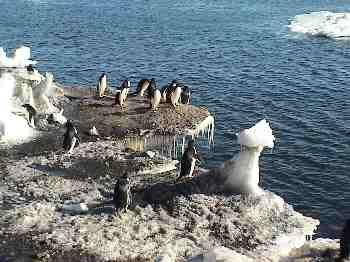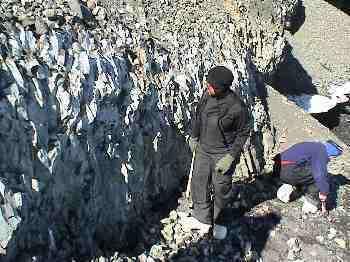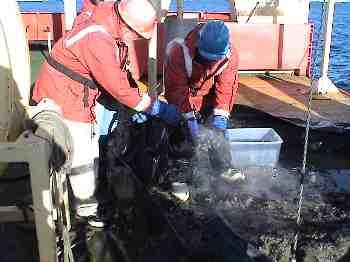23 January, 2004
The day started quietly with more multibeaming to map the seafloor.
We were still between icebergsB-15K and B-15A, working in the
ice-free area. During the night there had been a short shutdown of
the multibeam, but the electronic techs had it back online in no time.
By noon everyone was talking about a zodiac excursion to Franklin
Island to collect rocks for dating and chemical analysis by Sam
Mukasa from the University of Michigan. Initial plans were to send a
group of five to the island for about five hours to collect basalt
samples in hope that they contained mantle nodules. There were
concerns about ice around the island and its beach, so it was
uncertain whether the trip would occur at all.
The ship arrived about one and a half miles off the coast of Franklin
Island to much better conditions than expected. Captain Mike
approved one trip to the island with an inflated pontoon boat called
a zodiac. The zodiac is a small rubber motorboat that can hold about
12 to 15 people safely. As the preparations for deploying the zodiac
progressed, Ashley Lowe was able to get permission from the Captain
to include a much larger group than was initially planned. By 1:45,
arrangements had been made for a total of fourteen people from the
science party, ship support, and crew that were able to make the
two-mile trip to the island.
Everyone was dressed in float coats and cold weather gear, and each
person had bags or backpacks with extra clothes, water, food, cameras
and rock collecting gear. Sam Mukasa and Terry Wilson went with
Jenny White and Jesse Doren, marine techs, to scout out the beach and
possible rock collection sites. Terry and Sam were left at the
island to begin collecting and the zodiac returned to pick up the
rest of the group. We took the 2-mile ride in the zodiac though
small chunks of sea ice and bergs to the beach on Franklin Island.
We arrived at the beach to a small group of penguins making their way
to the ocean to feed. On a slope overlooking the beach is a large
penguin rookery. Thousands of adult birds and chicks stand sentry
over the beach from a hill overlooking the beach. The Antarctic
treaty specifies that animals in Antarctica should not have their
behavior affected by human observers. The penguins ignored our group
on the beach and continued on by us. We planned to collect rocks on
some steep outcrops that were accessible up steep loose gravel
slopes. In these areas penguins would not be an issue.
Using rock hammers, sledgehammers and our hands, we broke away chunks
of rock from the volcanic outcrops. The island looked like a
multicolored layer cake. The rock layers ranged in color from red to
black, with dominant colors in the grey and brown ranges. The layers
show the region of lava flows topped by ash fall from a volcano. The
outcrops were primarily basalts in shades of gray. The ash had
weathered into browns and reds. The geologists could detect small
differences in the color and structure of the rock that gives
information about their age and formation. We were also looking for
features in the rock called nodules. These are crystalline bodies in
the rock that form as the lava cools. The phenocrysts were green
with iridescent purple. The crystals are made from olivine; a
mineral that crystallizes first, at higher temperatures and pressures
than other minerals that make up the rock.
We were successful collecting about one hundred pounds of samples
from locations around the island. (Future entries will include more
detailed information about the rocks collected.) We returned to the
Palmer and made way for a volcanic formation on the seafloor that we
had observed from the preliminary seismic and multibeam data.
Larry had arranged for the marine techs to prepare the dredge to drag
across the seafloor in the area of the volcanic formation to collect
rocks that are on the seafloor. These rocks will give the scientists
information about the composition of the crust in this area, and
specifically about the volcanic feature that we observed from the
data. The dredge was deployed at about 8:00 PM. A large boom at the
stern cantilevers over the back of the ship allowing the dredge to be
lowered to the seafloor by a cable attached to a winch. Over 600
meters of cable were let out as the ship moved forward at about 2
knots. After 15 minutes of towing the dredge was retrieved onto the
back deck. The dredge was filled with sediment, rocks and
unfortunate sea creatures that were also caught.
It took over an hour to separate the rocks from the sticky, muddy
sediment using a hose spraying seawater and our hands and a shovel to
toss mud over the side. The rocks wore divided into piles of high
and low interest to the geologists. These piles were put in large
plastic containers to be transported into the wet lab. Over a
hundred pounds of rocks were taken to the wet lab where they will be
labeled and processed during the rest of the cruise for future
chemical analysis at the University of Michigan.

1. Penguins at Franklin Island.

2. Collecting Rocks at Franklin Island.

3. Dredge is emptied on deck.

Contact the TEA in the field at
.
If you cannot connect through your browser, copy the
TEA's e-mail address in the "To:" line of
your favorite e-mail package.
|
